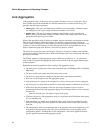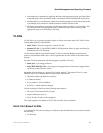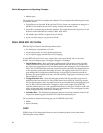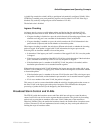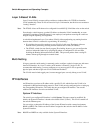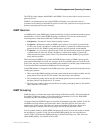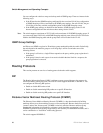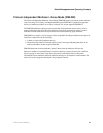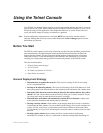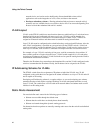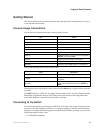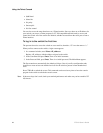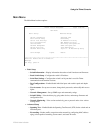38 ZT8101 User’s Manual
Switch Management and Operating Concepts
You can configure the switch to snoop and to keep track of IGMP groups. These two interact in the
following ways:
• If the IP interface has IGMP Snooping configured for the associated VLAN, the configuration
of IGMP Snooping will be overwritten by the IGMP group settings. On such VLANs, the per-
VLAN flag is the only available configurable option on the IGMP Snooping screen.
• If the IGMP group settings are disabled on the interface, IGMP Snooping on the VLAN
becomes configurable and the switch uses these settings for the VLAN.
Note: The switch supports a maximum of 255 VLANs and a maximum of 128 IGMP Snooping groups. If
you create more than 128 VLANs with IGMP Snooping enabled, some of those VLANs will not be
added to the IGMP Snooping table and the group’s data will be flooded in the VLAN.
IGMP Group Settings
An IP host uses IGMP to register its IP multicast group membership with the switch. Periodically,
the switch queries the multicast group to see if the group is still in use and takes one of the
following actions:
• If the group is still active, a single IP host responds to the query, and the group registration is
maintained.
• If the group is inactive and a report is not received within the time limit for a response, the
group registration is removed.
Routing Protocols
This section presents an overview of routing protocols that the switch supports.
RIP
The Routing Information Protocol (RIP) is a distance-vector protocol that uses hop count as its
criteria for making routing decisions. The ZT8101 switch supports both RIP v1 and RIP v2. You
can configure the following RIP options:
• Enable or disable RIP on the switch
• Enable or disable transmitting RIP packets on a specific IP interface
• Enable or disable receiving RIP packets on a specific IP interface
Distance Vector Multicast Routing Protocol (DVMRP)
The Distance Vector Multicast Routing Protocol (DVMRP) is a hop-based method of building
multicast delivery trees from multicast sources to all network nodes. Because the delivery trees are
“pruned” and use the “shortest path,” DVMRP is relatively efficient. Because multicast group
membership information is forwarded by a distance-vector algorithm, propagation is slow.
DVMRP is optimized for high delay (high latency) and relatively low bandwidth networks, and it
can be considered as a “best-effort” multicasting protocol.
The switch supports DVMRP v3.



